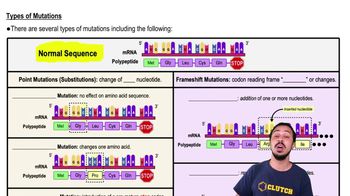Table of contents
- 1. Introduction to Biology2h 42m
- 2. Chemistry3h 40m
- 3. Water1h 26m
- 4. Biomolecules2h 23m
- 5. Cell Components2h 26m
- 6. The Membrane2h 31m
- 7. Energy and Metabolism2h 0m
- 8. Respiration2h 40m
- 9. Photosynthesis2h 49m
- 10. Cell Signaling59m
- 11. Cell Division2h 47m
- 12. Meiosis2h 0m
- 13. Mendelian Genetics4h 44m
- Introduction to Mendel's Experiments7m
- Genotype vs. Phenotype17m
- Punnett Squares13m
- Mendel's Experiments26m
- Mendel's Laws18m
- Monohybrid Crosses19m
- Test Crosses14m
- Dihybrid Crosses20m
- Punnett Square Probability26m
- Incomplete Dominance vs. Codominance20m
- Epistasis7m
- Non-Mendelian Genetics12m
- Pedigrees6m
- Autosomal Inheritance21m
- Sex-Linked Inheritance43m
- X-Inactivation9m
- 14. DNA Synthesis2h 27m
- 15. Gene Expression3h 20m
- 16. Regulation of Expression3h 31m
- Introduction to Regulation of Gene Expression13m
- Prokaryotic Gene Regulation via Operons27m
- The Lac Operon21m
- Glucose's Impact on Lac Operon25m
- The Trp Operon20m
- Review of the Lac Operon & Trp Operon11m
- Introduction to Eukaryotic Gene Regulation9m
- Eukaryotic Chromatin Modifications16m
- Eukaryotic Transcriptional Control22m
- Eukaryotic Post-Transcriptional Regulation28m
- Eukaryotic Post-Translational Regulation13m
- 17. Viruses37m
- 18. Biotechnology2h 58m
- 19. Genomics17m
- 20. Development1h 5m
- 21. Evolution3h 1m
- 22. Evolution of Populations3h 52m
- 23. Speciation1h 37m
- 24. History of Life on Earth2h 6m
- 25. Phylogeny2h 31m
- 26. Prokaryotes4h 59m
- 27. Protists1h 12m
- 28. Plants1h 22m
- 29. Fungi36m
- 30. Overview of Animals34m
- 31. Invertebrates1h 2m
- 32. Vertebrates50m
- 33. Plant Anatomy1h 3m
- 34. Vascular Plant Transport1h 2m
- 35. Soil37m
- 36. Plant Reproduction47m
- 37. Plant Sensation and Response1h 9m
- 38. Animal Form and Function1h 19m
- 39. Digestive System1h 10m
- 40. Circulatory System1h 57m
- 41. Immune System1h 12m
- 42. Osmoregulation and Excretion50m
- 43. Endocrine System1h 4m
- 44. Animal Reproduction1h 2m
- 45. Nervous System1h 55m
- 46. Sensory Systems46m
- 47. Muscle Systems23m
- 48. Ecology3h 11m
- Introduction to Ecology20m
- Biogeography14m
- Earth's Climate Patterns50m
- Introduction to Terrestrial Biomes10m
- Terrestrial Biomes: Near Equator13m
- Terrestrial Biomes: Temperate Regions10m
- Terrestrial Biomes: Northern Regions15m
- Introduction to Aquatic Biomes27m
- Freshwater Aquatic Biomes14m
- Marine Aquatic Biomes13m
- 49. Animal Behavior28m
- 50. Population Ecology3h 41m
- Introduction to Population Ecology28m
- Population Sampling Methods23m
- Life History12m
- Population Demography17m
- Factors Limiting Population Growth14m
- Introduction to Population Growth Models22m
- Linear Population Growth6m
- Exponential Population Growth29m
- Logistic Population Growth32m
- r/K Selection10m
- The Human Population22m
- 51. Community Ecology2h 46m
- Introduction to Community Ecology2m
- Introduction to Community Interactions9m
- Community Interactions: Competition (-/-)38m
- Community Interactions: Exploitation (+/-)23m
- Community Interactions: Mutualism (+/+) & Commensalism (+/0)9m
- Community Structure35m
- Community Dynamics26m
- Geographic Impact on Communities21m
- 52. Ecosystems2h 36m
- 53. Conservation Biology24m
15. Gene Expression
Mutations
Problem 7`
Textbook Question
Which of the following mutations would be most likely to have a harmful effect on an organism?
a. A deletion of three nucleotides near the middle of a gene
b. A single nucleotide deletion in the middle of an intron
c. A single nucleotide deletion near the end of the coding sequence
d. A single nucleotide insertion downstream of, and close to, the start of the coding sequence
 Verified step by step guidance
Verified step by step guidance1
Understand the types of mutations: Mutations can be insertions, deletions, or substitutions of nucleotides in the DNA sequence. Each type can have different effects depending on its location within the gene.
Consider the impact of a deletion of three nucleotides: Deleting three nucleotides may remove an entire codon, potentially affecting one amino acid in the protein sequence, but it does not cause a frameshift mutation.
Evaluate the effect of a single nucleotide deletion in an intron: Introns are non-coding regions, so a deletion here is less likely to affect the protein unless it disrupts splicing sites.
Analyze the consequence of a single nucleotide deletion near the end of the coding sequence: This could lead to a frameshift mutation, altering the reading frame and potentially affecting the protein's function.
Assess the impact of a single nucleotide insertion near the start of the coding sequence: An insertion here can cause a frameshift mutation, which is likely to have a significant effect on the protein's structure and function.
 Verified video answer for a similar problem:
Verified video answer for a similar problem:This video solution was recommended by our tutors as helpful for the problem above
Video duration:
1mPlay a video:
Was this helpful?
Key Concepts
Here are the essential concepts you must grasp in order to answer the question correctly.
Gene Mutations
Gene mutations are changes in the nucleotide sequence of DNA, which can affect the structure and function of proteins. Mutations can be classified as point mutations, insertions, deletions, or duplications, each having different impacts on the organism depending on their location and nature. Understanding how mutations alter genetic information is crucial for assessing their potential harm.
Recommended video:
Guided course

Mutations
Frameshift Mutations
Frameshift mutations occur when nucleotides are inserted or deleted from the DNA sequence, altering the reading frame of the gene. This can lead to significant changes in the amino acid sequence of the resulting protein, often resulting in nonfunctional proteins. Frameshift mutations are typically more harmful than point mutations because they affect all downstream codons.
Recommended video:
Guided course

Types of Mutations
Coding Sequence
The coding sequence of a gene is the portion of DNA that is transcribed into mRNA and translated into a protein. Mutations within the coding sequence can directly affect protein synthesis, potentially leading to dysfunctional proteins. The location of a mutation within the coding sequence, such as near the start or end, can influence its impact on protein function and organismal health.
Recommended video:
Guided course

Genetic Code





